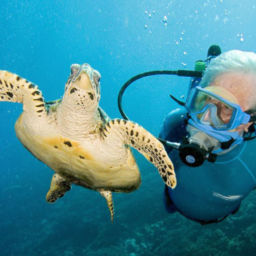There’s a new shark dive in Fiji at Barefoot Kuata Resort in the southern Yasawa Islands. And you can dive with bull sharks, lemon sharks, blacktip reef sharks — and even the odd tiger shark — on a Discover Scuba Diving experience.
How does the new shark dive work?
The Awakening Shark Dive is brainchild of shark expert Dr. Thomas Vignaud. After completing his Ph.D. on sharks, he combined the latest scientific information, experience from other shark dives and his own ideas to design a safe, easy and sustainable shark dive. The resort’s newly-appointed resident marine biologist, Helen Armstrong, runs the dive with help from a team of experienced Fijian shark feeders and dive guides. Most of them have years of experience on the established shark dives in Beqa Lagoon.
The dive happens each morning at 8 a.m. and 11 a.m. and is just a 15-minute boat ride from the island resort. The 8 am session is for certified divers only. Small groups of divers visit the site, which is in just 60 feet (18 m) of warm, clear water. They sit behind a low wall of coral rubble, with ‘guards’ to the left, right and behind them.
The sharks are fed either on the ground in front of the onlookers or in open water a few feet above the ground using fish heads. Feeders hold the bait out on extendable poles into the middle of the arena. This provides the perfect opportunity to see the apex predators up close, as well as a clear view for photographers.
Vignaud has chosen the site well, with a steep coral wall at the back, which curves around the viewing area, and a wide, open sandy arena for the sharks to maneuver back and forth and grab a bite to eat.
Discover Scuba Diving experience
At 11 a.m. there is a shallower dive in about 33 feet (10 m) closer to the reef wall, where those with no dive experience can have a similar encounter. Before the dive, participants learn the basics of diving in the shallows at the resort, just as they would on any Discover Scuba experience. They’re also given clear instructions on required behavior around sharks.
There is a good diver-to-guide ratio, with enough guides available to escort any divers who want to leave the dive early — whether scared or just low on air — and still leave enough to stand guard for the remaining divers.
How’s the experience?
Both dives are very well-managed. On the Discover Scuba dive, the team took great care of a group of six uncertified participants, most of whom had never dived before. While some admitted fear, no one panicked, and all of them emerged from the water with huge grins on their faces.
The most common shark species you’ll see here are bulls, but 10 different shark species, including tigers and great hammerheads have been recorded over the last two years.
The team has also run several scientific programs, using the presence of these sharks as an opportunity to learn more about them. For example, they now know that fewer bull sharks appear after October when they’re undergoing hormonal changes prior to their November/December mating season. During this time other sharks appear more frequently.
The team shares research results with some of the other shark-dive operators in Fiji, enabling operators to better understand of shark behavior and how far they travel. Indeed, some of the same sharks have been identified in both locations, hundreds of miles apart.
Shark diving is often considered the domain of only experienced, hard-core divers, but the shallow depth and easy access of this new shark dive make it suitable for newly qualified open-water divers or even for those with no experience at all.





